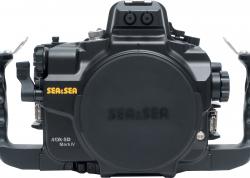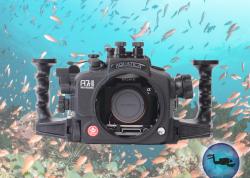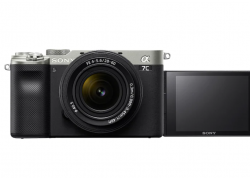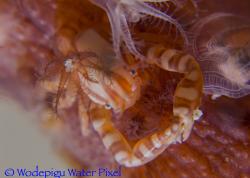Canon S100: In-Depth Thoughts And Housing Reviews
As a frequent diver and underwater photographer, lately I have observed that more and more people who go underwater are equipped with some kind of camera. In fact, I'd say it's rare for a diver to go out without one. This might be because of the increasing affordability of the hobby, or perhaps because of the knowledge that the underwater world is deteriorating and the collective desire to archive its current beauty. Naturally, compact cameras make up the bulk of the market, and some premium options even come tantalizingly close to dSLRs in terms of image quality. Canon has always been at the forefront of producing amazing compacts for underwater photographers, and the new S100 model promises to build significantly on the popularity of its predecessor, the S95.

The S100 is slightly bigger than the S95 but comes with more features and still fits easily in your hand.
My first impression of the Canon S100 when I took it for a spin in Tioman Island was very positive. The camera proved to be good at capturing fantastic shots with vivid colors and great detail. While selecting your camera is only half the battle, the next step is finding a housing, which we will discuss in-depth further down in this article. There are many housings on the market for the Canon S100 for different tastes and budgets. Remember that not all housings are created equal, and in this article I will evaluate the differences between the “budget” and “premium” options. I'll specifically be looking at the S100 housings from Ikelite, Fisheye FIX and Recsea.
The S100 Familiarized
Many articles have been made available with reviews and technical specifications for the S100, including my own “First Impressions” article here on the Underwater Photography Guide. After having more time to tinker with the camera, here are some important insights to be added:
For a compact of this size, the ergonomics have proven to be excellent. The dials for aperture and shutter are well placed, allowing single-handed operation should the need arise. Selecting ISO requires a single touch on the RING FUNC button and using the rear dial to achieve the desired setting.
The increase in zoom range from 3.8X to 5X gives a camera of this size greater flexibility than compact users may be used to. Of even greater importance is achieving a field of view of 24mm at its widest setting. Underwater this gives an effective field of view of 30mm, which instead of 35mm of the S95 and G12, allows the photographer to get closer to the subject and illuminate it better when employing strobes.
Video output from the S100, especially in low light, is excellent due to the wide f2.0 aperture at its widest setting. This is especially helpful for users who are shooting video without using video lights. Coupled with the close focusing distance of 3cm means the S100 is able to take video clips fairly sized (8cm/3inches or bigger) macro subjects without adding external enhancements like macro lenses.
ISO settings of up to 400 can be selected without much loss in image quality and fine detail. Having upgraded the S100 from a 10-megapixel sensor to the 12-megapixel one, image detail is more effectively retained. These two qualities are great for newly minted photographers who may not have external strobes to light up their photos. Advanced users taking ambient light photography will also appreciate these attributes. In short, this camera is more forgiving than ever before out of the box.
Of course, there are some less favorable things to note:
The Live View on the S100 can lag very considerably in low light conditions, and it takes awhile for the camera to catch back up once it starts to lag. Adding a focus light, even with is turned on at all times, does nothing to rectify the situation. I had the luxury of having two S100s to work with, and both gave me the same results, so this could be a firmware problem that I hope will be rectified on the upgrade.
The lens “breathes” when it's focusing, shifting back and forth to achieve focus. This may result in incorrect framing of the subject when it is in focus, meaning the subject as seen on the LCD could be bigger or smaller than what the photographer intended.
The autofocus absolutely rocks… when it works, that is. When the S100 is put through its paces underwater the autofocus takes longer to lock on as compared to on land. When it does lock on, the focus accuracy is perfect only 70% of the time. This issue is exacerbated when deploying macro lenses, so users who are used to focusing “within the ballpark” and relying on the camera’s autofocus to achieve final focus accuracy may find it harder to get the results desired. Even when moving the camera back and forth and relying on your eyes to get focus accuracy, upon half-shutter the autofocus may make the image even more out of focus than before. Using focus check is a must when taking macro subjects. A firmware upgrade may solve these problems, but for now users may have to put more effort into achieving the perfect shot. Of course, it has to be mentioned that when focus accuracy is achieved the contrast and details in the image are excellent.

What the S100 is capable of. Whip boby taken with twin Sea & Sea YS-110a strobes at ISO 80. Manual mode at f8 and 1/250s. Subsee +10 macro lens.
S100 Housings: which one?
With a slew of underwater housings available, it's easy to get overwhelmed and become unsure which will be right for you. Each will allow for beautiful photos and of course keep your camera dry, but the devil is in the details as each manufacturer has different methods of allowing access to the camera controls.

Ikelite S100 Housing.
Canon actually markets their own underwater housing for the S100, but most buyers would opt to pay a little more to get the Ikelite offering. With a much tougher polycarbonate shell and better quality buttons and control levels compared to the dinky ones on the Canon housing, the Ikelite option will easily outlast your S100 and another one. Ikelite also manufactures their own accessories like external strobes and add-on lenses that integrate seamlessly with their housings, so there are no shortage of options should you want to take your photography further. With a maximum depth rating of 60 meters, the Ikelite housing is more than capable of operating within recreational dive limits, especially compared to the Canon housing's maximum depth of 40 meters. The Ikelite is a no-frills housing perfect for starting off your underwater photo adventures.
The Ikelite housing fits in the palm of your hand, with easy access to all the control buttons and levers. However, to use the control ring dial on the housing a plastic gear ring has to be installed on the front control ring itself. The gear ring is fairly tight and there have been cases where repeated dismantling and installing causes it to break, so if possible the gear ring should be left on the control ring. Setting the camera into the housing is a simple task of slotting the camera within the space marked out by the pylons and making sure the gear ring on the control ring on the S100 meshes solidly with the control ring dial on the housing. The lens port of the housing conveniently features a 67mm thread to allow the photographer to use “wet” macro and wide-angle lenses.

67mm thread at the front of the lens port.
Of all the controls on an underwater housing, that which activates the shutter button is arguably the most important, for the mechanism has to be tactile enough for the user to feel the “half press” detent on the camera but still offer enough resistance to ensure the shutter is not inadvertently fully depressed. A well-engineered shutter control should allow the photographer to activate half shutter to see if the subject is in focus and also utilize features like focus check for further fine-tuning and take the shot only when the photographer chooses to. Ikelite has opted for the shutter lever where the movement to depressing the shutter is akin to pulling a trigger on a pistol.

How the Ikelite shutter lever depresses the shutter button.
Using strobes takes a little extra preparation, as the Ikelite housing does not come equipped with any method to trigger external strobes for both sync cords and fiber optic cable. The easiest way to use strobes with this housing is via fiber optic cable, the common method being to stick on a velcro removable pad embedded with an open fiber optic cable end, right in front of the camera flash unit on the top right hand corner of the housing. A more elegant route is to paste a strobe mask set like those offered by Sea & Sea. The strobe mask set allows you to use dedicated fiber optic cables for underwater strobes and ensures a reliable activation of the strobes when needed. If the photographer has two strobes it is also a simple task to get a rubber bush offered by Inon and slot two open fiber optic cable ends through the bush on the housing.

A bit of DIY work but gets the job done.
Now that we're prepared let's take the housing underwater!
Through the paces
The S100 Ikelite housing with the camera inside feels slightly heavy in the water but not enough to warrant rethinking the weights one uses while diving. When attempting to turn the camera on you will realize how stiff the controls are on the housing. In fact, all the buttons on the housing, save for the shutter lever, are extremely stiff and it takes some effort to use the buttons to access features on the S100.
Another issue occurs when trying to use the zoom dial. There is no return spring on the level to get the zoom lever back to its neural position after using it. Should the user forget to manually shift the dial back to its original position the zoom lever on the camera stays permanently on the zoom in or out, causing the S100 to freeze up. When the camera “freezes up,” using any control on the housing will illicit a non-response from the camera and the shutter button will not allow any picture to be taken. If this occurs underwater you will need to check your zoom dial.

The zoom lever (middle) stuck at zoom-in position. It needs to be rotated back manually.
The 67mm female threads are well made and screw in very comfortably. However, at shallow waters (5 meters and shallower) and in good light there is a some glare from the housing that may impede your view of the LCD screen. This problem becomes worse if the photographer is taking macro subjects with macro lenses and manual focusing is needed.
The shutter lever and the front control dial work well underwater with no discernible issues at all. By now the Ikelite user will have realized that there is an omission on the housing that may come to be viewed as a deal breaker for potential buyers: there is no dial on the housing to rotate the rear ring on the S100. This means that the user is not able to easily manipulate both the aperture and shutter speed to get the desired exposure, with the photographer essentially having to have one at a fixed setting and use the front control ring to adjust the other. With these constraints in mind some possible compromises are suggested:
For the most hassle-free compromise, set the camera to aperture priority or Av mode using the front ring to control the aperture. This allows the camera to decide the correct shutter speed given the size of the aperture you want to shoot to get the right exposure.
For more advanced users you can set the front control ring of the S100 to set shutter speed, choosing a fixed aperture before going underwater. Why not set the ring to control aperture instead? This is because shutter speed is a more effective way of controlling ambient light than adjusting the aperture, simply because compacts have a limited range of aperture settings due to the small sensor size. Shutter speed also has the advantage of reducing camera shake and freezing motion. For example, should the photographer want to incorporate a sunburst in the background shutter speeds of up to 1/1000s can be used whereas the maximum aperture on the S100 is only up to f8, so if your shutter speed has been set too slow it is virtually impossible to capture the sunburst effectively. If using strobes shutter speed becomes more important because the photographer will usually set a small aperture for a deeper depth of field and uses the shutter speed to control the amount of ambient light in the background.
There actually is a way to use the rear dial to control the aperture or shutter. This involves holding down the ring function button and choosing the settings via the macro button and the flash control button. Unfortunately all the controls are on the right side of the camera, making it extremely difficult to make changes efficiently. A convoluted two-handed position is needed to make changes via the rear dial effectively, and with practice one can make it second nature, but it may take up too much time before the photo opportunity is spurned.
Fisheye FIX S100 Housing
At the other end of the spectrum is the S100 housing from Fisheye FIX. Instead of using clear polycarbonate, this housing is constructed using corrosion-resistant aluminum alloy and can be taken to a depth of 70 meters, which accounts for its heft over Ikelite and a price tag that is almost three times as much. However, FIX sweetens the deal with a few useful add-ons bundled along with the housing, providing not one but two lens adaptors with 52mm and 67mm screw threads, and more importantly for users needing to trigger external strobes, an optical cable adaptor that can be fitted over the flash port on the housing. There is no need to fit a gear ring on the S100’s front control ring, and the camera fits into the housing smoothly and tightly, with very little chance of an improper mount. The direct video record button on the housing is colored red, which is a nice thought from Fisheye as a visual cue to users what that button is expressly used for.

The FIX S100 housing. Great build quality at your fingertips.

The optical cable adaptor. You do get what you pay for.
There are three crucial differences between the Ikelite and FIX housings that deserve special attention:
The shutter lever on the FIX, unlike the pullback trigger style of the Ikelite housing, is a vertical lever that mimics the operation of the shutter button on the S100 itself. Having a preference for either design is subjective, and if possible it is best to try out both housings to form your own impressions. The Ikelite shutter level feels more natural with regards to movement of the fingers, although I find it easier to achieve and hold the “half-shutter” position when using the FIX housing.
The zoom control lever has a return spring that nudges the zoom lever on the S100.
There is a rotary knob on the back of the FIX housing that allows you access to the rear dial. This means that the FIX housing allows you to operate the camera as you would on terra firma. Compared to the Ikelite, the FIX housing has a clear advantage in terms of ergonomics.

The dreaded red button.

The shutter lever operates “naturally."
Through the paces
Remarkably the FIX housing with its aluminum-alloy construction weighs slightly less than the Ikelite housing, but it becomes negatively buoyant underwater. Complementing the housing with strobes will almost certainly require you to take off some dive weights. All the control buttons and levers can be accessed with just your right hand and the housing is a breeze to use underwater. All the buttons are easy to press and both front and rear dials move freely, making fine adjustments on the camera quick and painless. Having a return spring on the zoom lever means that the camera never hangs anymore as the zoom lever is never stuck any extreme position.
The lens mount accepted all my wet lenses smoothly, and since both the 52mm and 67mm lens mounts are screwed onto the lens port externally, it is possible to employ both of them underwater. The FIX S100 is actually more compact than the Ikelite offering, which along with its great ergonomics makes this housing a breeze to use.
The main (and arguably only) pitfall of the FIX S100 housing is how easily the user can inadvertently depress the direct video record while diving. The direct video button is situated just below the thumb rest, which makes it easy for the thumb joint to accidentally depress it. In almost every dive I have inevitably come up a few “candid” videos mixed in with my intended footage. I thought that after some time with the housing I would have learned to avoid the button, but after eleven dives it still occurs.
Recsea Canon S100 housing
Although we didn't get a chance to review the Recsea S100, the Recsea S100 is also an excellent choice, allow full control of both aperture and shutter speed. The housing offers a large front control dial, which allows for easy use with heavy gloves, a large rear control dial, and 2 housing o-rings for added security.
The Recsea S100 housing also allows for use of an innovative quick-adapt system, which allows for easy adding and removing of wet lenses.
You can read several Recsea S100 reviews on the Bluewater Photo store website.
Conclusion
The Canon S100 is without a doubt a very prudent choice among compact cameras for underwater photography, especially if your main requirements are superb image quality in as diminutive a package as possible. There may be some hiccups while deploying the camera underwater but with some patience there is nothing to stop the photographer from getting amazing pictures.
Now comes the question: which underwater housing should you invest in? The Ikelite housing offers superb value, particularly for divers delving into underwater photography for the first time. Most of these new underwater photographers will probably start off with the camera in auto or aperture priority mode, so not being able to use the rear dial may not be an issue. More experienced users, who do not mind to work the buttons for full manual flexibility and some extra preparations for use with strobes, will also find the Ikelite housing a compelling choice because the quality of the construction offers exceptional value for prolonged and heavy usage.
The FIX housing and Recsea S100 housings presents what is arguably the last word in underwater housing quality and ergonomics for the S100. The high quality controls allow one-handed operation and with the inclusion of a rear dial rotary knob the housing allows total and easy manual operation. The lofty price tag may deter some buyers, but the conveniences offered by the housing will persuade some that the premium is worth paying for. The Recsea and FIX S100 housings will be greatly appreciated by advanced users needing the full access to manual operation of the S100 and aspiring photographers who have made the decision to use the S100 for the photographic needs for the long term.
Further Reading
RECOMMENDED ARTICLES
SUPPORT THE UNDERWATER PHOTOGRAPHY GUIDE:
The Best Service & Prices on u/w Photo Gear
 Visit Bluewater Photo & Video for all your underwater photography and video gear. Click, or call the team at (310) 633-5052 for expert advice!
Visit Bluewater Photo & Video for all your underwater photography and video gear. Click, or call the team at (310) 633-5052 for expert advice!
The Best Pricing, Service & Expert Advice to Book your Dive Trips
 Bluewater Travel is your full-service scuba travel agency. Let our expert advisers plan and book your next dive vacation. Run by divers, for divers.
Bluewater Travel is your full-service scuba travel agency. Let our expert advisers plan and book your next dive vacation. Run by divers, for divers.



































